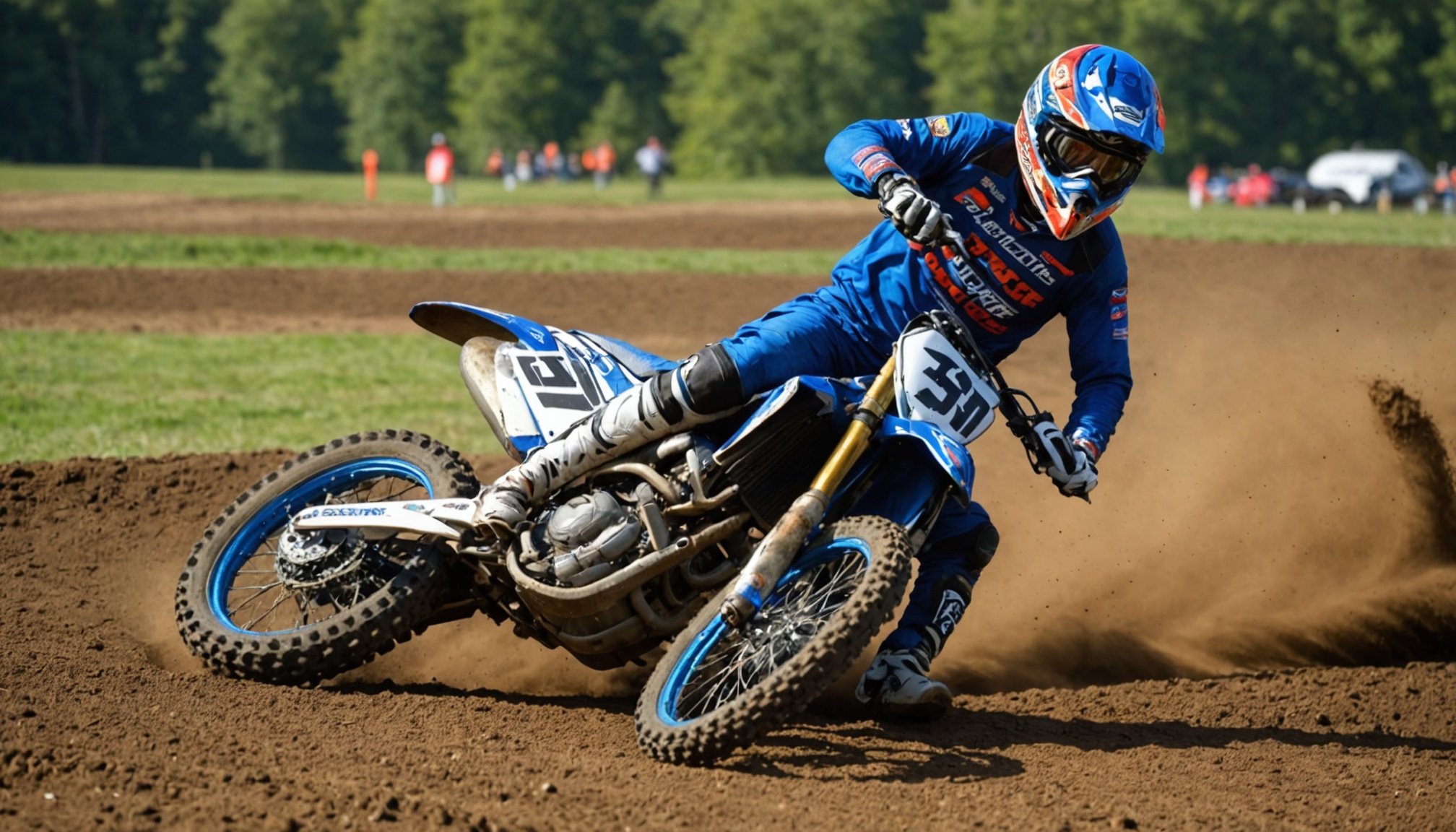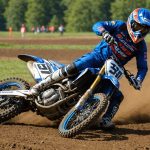Understanding Cornering Dynamics
In motocross, mastering cornering dynamics is crucial for achieving optimal motocross bike performance and enhancing race dynamics. The physics of cornering involves controlling centrifugal force, traction, and gravity, which are all pivotal to razor-sharp cornering techniques.
Body positioning and weight distribution play a significant role in effective cornering. Leaning into the corner with the appropriate position shifts your body weight in a way that counters the outward push of centrifugal force. This adjustment helps maintain stability and speed, which are essential to maximizing the bike’s performance.
Topic to read : Elevate your fencing footwork: discover the key techniques for boosting speed and agility
Several key factors affect cornering speed, such as the angle of the corner, the surface grip, and the bike’s geometry. Understanding how each element interacts provides the insight needed to harness your bike’s full capacity. For instance, tighter angles require more precision and balanced braking to prevent sliding.
Emphasizing these cornering techniques ensures consistent performance in competitive scenarios. Proper body awareness and being discerning about weight shifts translate to smoother transitions through turns, directly influencing overall race pace and reliability in different track conditions. Recognizing these dynamics allows riders to push boundaries while maintaining safety and control.
Also to read : Unlocking Precision: Essential Mental Drills for Biathletes to Enhance Shooting Accuracy
Essential Cornering Techniques
Precision cornering revolves around three core elements integral to motocross success: body positioning, throttle control, and line selection. Mastering these techniques is essential for improving overall motocross bike performance.
Body Positioning for Optimal Cornering
Achieving precision demands that a rider fine-tune their body positioning. Maintaining the correct body alignment allows for better balance and reduces the chances of mishaps in tight turns. Proper posture involves keeping elbows up, maintaining a loose grip, and ensuring the knees grip the bike for stability.
Managing Throttle and Braking
Throttle control in motocross is crucial, primarily to ensure smooth acceleration and maintain grip. Braking control facilitates a timely reduction in speed before entering a corner, setting the groundwork for a smooth exit. Balancing these elements prevents loss of traction, improving both speed and confidence in corners.
Choosing the Right Line
Line selection—picking the optimal path through a corner—can make a significant difference in race dynamics. Inside lines generally offer a shorter path but may require precise technique, while outside lines provide more room for maneuvering but can be riskier. Considering track conditions and visualizing the corner beforehand aids in consistent performance.
Drills to Enhance Cornering Skills
To improve cornering skills in motocross, engaging in focused motocross drills is essential. These are designed to sharpen technique and build confidence.
Drills for Body Positioning
Practising body positioning drills helps riders maintain balance and control during turns. Position cones in a circular pattern, mimicking a race corner. As you navigate the circle, concentrate on keeping elbows up and applying consistent pressure with your knees against the bike. This exercise ensures the correct body alignment and enhances rider stability.
Exercises for Throttle Control
Mastering throttle control is pivotal for smooth transitions in and out of corners. Create a practice area with varied track conditions. Perform stop-and-go exercises to balance acceleration and deceleration. Focus on gradual throttle engagement to prevent the bike from losing traction. This builds muscle memory for maintaining optimal speed.
Simulated Cornering Practice
Simulated cornering techniques involve using markers on a track to visualize line selection. Set up a series of cones to represent different corner types. Experiment with different lines, noting which offers the best balance between speed and control. Adjusting approach tactics in response to these exercises significantly boosts motocross bike performance.
Insights from Experienced Riders
In the competitive world of motocross, understanding the nuances of cornering can drastically improve motocross bike performance. Professional motocross tips from seasoned riders offer invaluable insights into mastering these cornering techniques.
Interviews with Top Riders
Experienced riders emphasize the significance of precise precision cornering and share strategies that make a difference. For instance, top riders often highlight the importance of adaptability. Adjusting body positioning and throttle control according to track conditions can make or break a rider’s race dynamics. These insights emerge from the collective experience and are tailored through continuous practice.
Common Tips for Cornering Success
Based on accomplished racers’ advice, maintaining a strong focus on throttle control and optimal line selection plays a critical role. Riders noted that visualizing and planning corners before execution aids in maintaining speed and balance. Consistently practising these elements can substantially boost a rider’s confidence and capability.
Analyzing Race Techniques
Analyzing race footage allows riders to identify advanced strategies employed during actual races. Observing how professional racers handle specific tracks highlights effective communication between riders and their coaches. This feedback loop is crucial in honing skills, understanding race dynamics, and achieving consistent excellence in motocross competitions.
Bike Setup for Cornering Excellence
Achieving cornering performance in motocross isn’t just about technique—your bike setup plays a pivotal role in optimising performance. Proper adjustments can make a significant difference in maintaining stability and grip.
Importance of Suspension Adjustment for Cornering
Suspension settings are critical for absorbing shocks and maintaining traction during cornering. Adjusting the suspension to your weight and riding style ensures that your bike responds effectively to track conditions, enhancing cornering performance. A well-tuned suspension offers better control, reducing the likelihood of a wobble or a slip.
Tire Selections and Pressures for Optimal Grip
Tire choice is fundamental; selecting the right model depends on track surface and weather. For optimum cornering performance, adjust tire pressures to find the sweet spot between grip and stability. A tire with too much air reduces contact with the ground, whereas too little can cause sluggish handling.
Maintenance Tips to Ensure Reliable Cornering Performance
Regular bike maintenance is necessary for bike tuning. Ensure that crucial components like brakes, chain, and bearings are in top condition to prevent malfunctions mid-race. Consistent checks and tweaks not only bolster your motocross bike performance but also help avoid unnecessary strain on bike parts during intense cornering dynamics.
Common Mistakes to Avoid in Cornering
Mastering cornering means understanding common cornering errors that can dramatically hinder race performance. Recognising and rectifying these mistakes not only sharpens skills but also improves overall race performance.
Overcoming Common Pitfalls
Riders frequently misjudge entry speed, leading to overshooting or poor line execution. This hampers control and pace. Ensuring precise throttle input and line selection reduces such errors. Pay attention to body posture; inappropriate positioning leads to imbalance, affecting overall performance.
Preventing Understeering and Oversteering
Managing both understeering and oversteering is paramount in refining cornering techniques. Understeering usually occurs with insufficient steering into a turn due to a lack of front-tire grip. Contrarily, oversteering happens when the back tire loses traction, over-rotating the bike. To navigate these issues, focus on balanced throttle control and intuitive braking techniques.
Identifying Personal Mistakes
Regular self-analysis reveals personal rider mistakes. During practice, utilize technology or a training partner to observe and provide constructive feedback. Create a feedback loop to adjust and improve techniques. Embracing these insights allows precision in execution, crucial for competitive dynamics. By understanding and addressing these errors, riders enhance their competitive edge.











